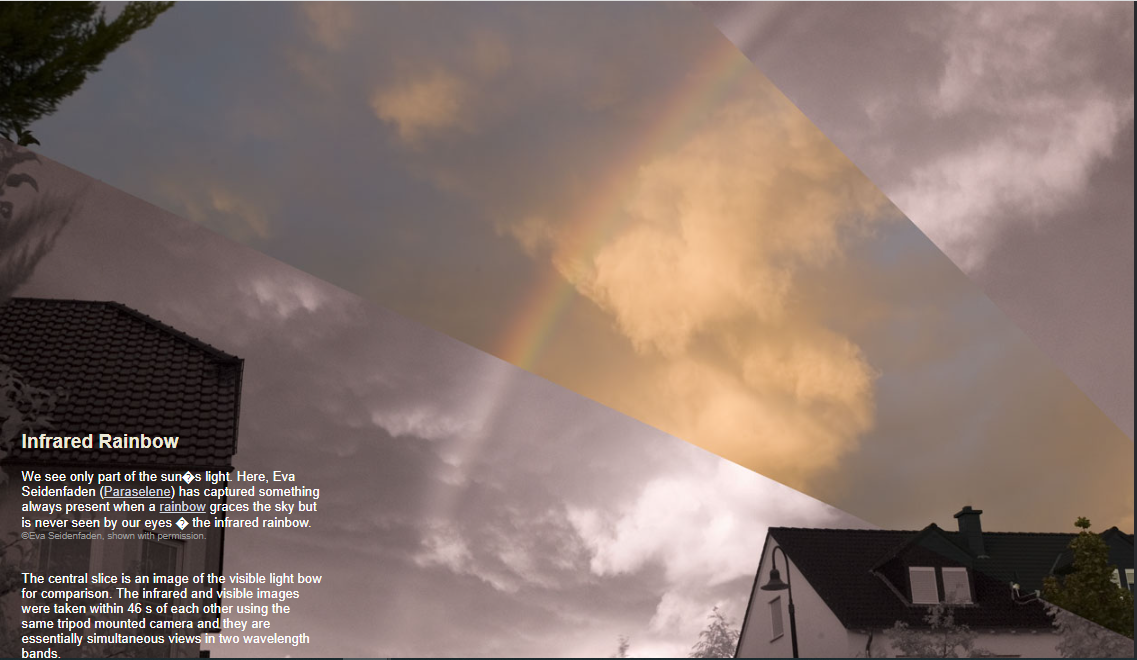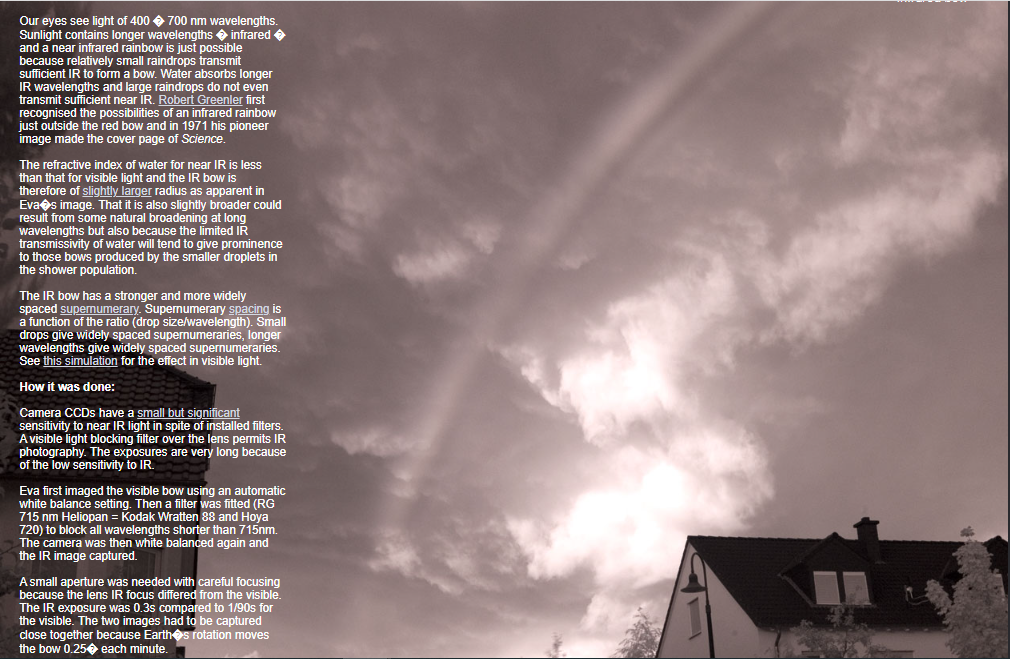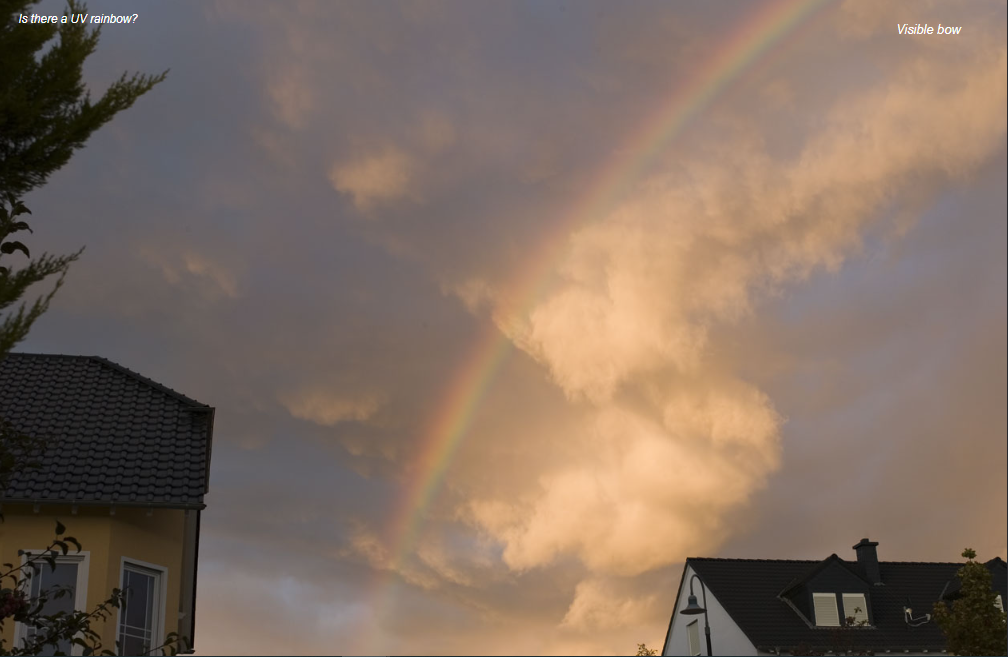OPOD - Infrared Rainbow
OPOD - Infrared Rainbow: Unveiling the Hidden Spectrum of Light
Rainbows are a captivating natural phenomenon that never cease to amaze us. But did you know that there is more to rainbows than meets the eye? While our vision can only perceive a portion of the sun's light, there is an invisible realm of colors that lies beyond our sight. Enter the realm of the infrared rainbow, a captivating spectacle that is always present but remains hidden from our eyes.
The infrared rainbow, captured here by the talented photographer Eva Seidenfaden, unveils a fascinating aspect of rainbows that is seldom seen. In this mesmerizing image, the central slice represents the visible light bow, providing a basis for comparison. Remarkably, the infrared and visible images were captured within a mere 46 seconds of each other, using the same tripod-mounted camera. These simultaneous views in two different wavelength bands shed light on the hidden beauty of the infrared rainbow.
Exploring the Enigmatic Bow
Our eyes are sensitive to light with wavelengths ranging from 400 to 700 nanometers (nm). However, sunlight contains longer wavelengths, including infrared (IR) light. It is this extended range of wavelengths that gives rise to the possibility of an infrared rainbow. Unlike larger raindrops that do not transmit sufficient near IR due to water's absorption properties, relatively small raindrops have the ability to transmit enough IR to form a bow. It was Robert Greenler who first recognized the potential for an infrared rainbow just outside the red bow. In fact, his pioneering image of an infrared rainbow adorned the cover page of Science in 1971.
The refractive index of water for near IR is lower than that for visible light, resulting in a slightly larger radius for the IR bow, as evident in Eva's image. Additionally, the IR bow appears slightly broader, which could be attributed to both natural broadening at longer wavelengths and the limited IR transmissivity of water. This limited transmissivity tends to highlight the bows produced by the smaller droplets in the shower population, thereby contributing to the broader appearance.
Furthermore, the infrared bow exhibits a stronger and more widely spaced supernumerary, which are the additional faint bands of colors that sometimes accompany the main bow. The spacing of these supernumeraries is influenced by the ratio of drop size to wavelength. In the case of the IR bow, the combination of smaller drops and longer wavelengths leads to widely spaced supernumeraries. To visualize the effect of this phenomenon in visible light, a simulation can be observed.
Unveiling the Invisible: How It Was Done
Capturing the infrared rainbow required a specialized approach. Although camera CCDs possess a slight sensitivity to near IR light, they are equipped with filters to block most of it. By fitting a visible light blocking filter (RG 715 nm Heliopan = Kodak Wratten 88 and Hoya 720) over the lens, Eva was able to enable IR photography. To ensure accurate focusing, a small aperture was used, as the lens's IR focus differed from that of visible light. The exposure time for the IR image was significantly longer than for the visible image due to the low sensitivity to IR light. Care was taken to capture both images in close succession since Earth's rotation causes the bow to shift approximately 0.25° per minute.
Unraveling the Mysteries: More Infrared Bows
The infrared rainbow is just one example of the hidden wonders that lie beyond our visual perception. As technology and techniques continue to advance, we gain greater insight into these enigmatic phenomena. Exploring the hidden realms of rainbows not only enhances our understanding of atmospheric optics but also unveils the sheer beauty that exists beyond what our eyes can behold.
Is There a UV Rainbow?
While the infrared rainbow has captivated our imaginations, you may wonder if there is a corresponding ultraviolet (UV) rainbow. Unfortunately, the answer is no. Our eyes are simply not sensitive enough to perceive the shorter wavelengths of UV light. UV rainbows exist beyond the limits of human vision, but they remain concealed from our sight.
As we continue to delve into the mysteries of atmospheric optics, we uncover a world of captivating phenomena that were once hidden from view. The infrared rainbow serves as a testament to the intricate interplay between light and nature, revealing the breathtaking beauty that lies just beyond the realm of our vision. So, the next time you witness a rainbow gracing the sky, remember that there is more to it than meets the eye.

Infrared Rainbow
We see only part of the sun�s light. Here, Eva Seidenfaden (Paraselene) has captured something always present when a rainbow graces the sky but is never seen by our eyes � the infrared rainbow.
©Eva Seidenfaden, shown with permission.
The central slice is an image of the visible light bow for comparison. The infrared and visible images were taken within 46 s of each other using the same tripod mounted camera and they are essentially simultaneous views in two wavelength bands.
About the bow:

Our eyes see light of 400 � 700 nm wavelengths. Sunlight contains longer wavelengths � infrared � and a near infrared rainbow is just possible because relatively small raindrops transmit sufficient IR to form a bow. Water absorbs longer IR wavelengths and large raindrops do not even transmit sufficient near IR. Robert Greenler first recognised the possibilities of an infrared rainbow just outside the red bow and in 1971 his pioneer image made the cover page of Science.
The refractive index of water for near IR is less than that for visible light and the IR bow is therefore of slightly larger radius as apparent in Eva�s image. That it is also slightly broader could result from some natural broadening at long wavelengths but also because the limited IR transmissivity of water will tend to give prominence to those bows produced by the smaller droplets in the shower population.
The IR bow has a stronger and more widely spaced supernumerary. Supernumerary spacing is a function of the ratio (drop size/wavelength). Small drops give widely spaced supernumeraries, longer wavelengths give widely spaced supernumeraries. See this simulation for the effect in visible light.
How it was done:
Camera CCDs have a small but significant sensitivity to near IR light in spite of installed filters. A visible light blocking filter over the lens permits IR photography. The exposures are very long because of the low sensitivity to IR.
Eva first imaged the visible bow using an automatic white balance setting. Then a filter was fitted (RG 715 nm Heliopan = Kodak Wratten 88 and Hoya 720) to block all wavelengths shorter than 715nm. The camera was then white balanced again and the IR image captured.
A small aperture was needed with careful focusing because the lens IR focus differed from the visible. The IR exposure was 0.3s compared to 1/90s for the visible. The two images had to be captured close together because Earth�s rotation moves the bow 0.25� each minute.
More IR bows.
Is there a UV rainbow?

Note: this article has been automatically converted from the old site and may not appear as intended. You can find the original article here.
Reference Atmospheric Optics
If you use any of the definitions, information, or data presented on Atmospheric Optics, please copy the link or reference below to properly credit us as the reference source. Thank you!
-
<a href="https://atoptics.co.uk/blog/opod-infrared-rainbow/">OPOD - Infrared Rainbow</a>
-
"OPOD - Infrared Rainbow". Atmospheric Optics. Accessed on April 19, 2024. https://atoptics.co.uk/blog/opod-infrared-rainbow/.
-
"OPOD - Infrared Rainbow". Atmospheric Optics, https://atoptics.co.uk/blog/opod-infrared-rainbow/. Accessed 19 April, 2024
-
OPOD - Infrared Rainbow. Atmospheric Optics. Retrieved from https://atoptics.co.uk/blog/opod-infrared-rainbow/.